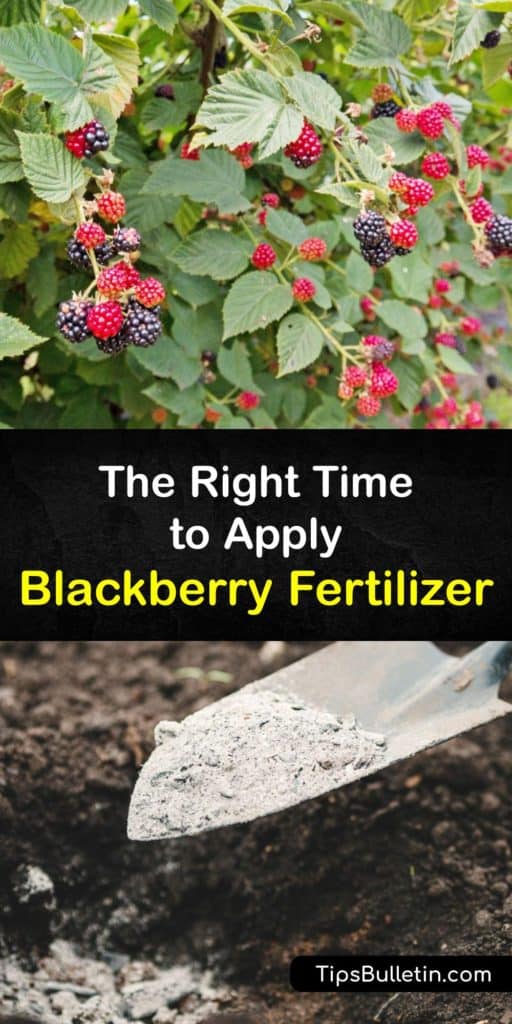There is nothing better than picking fresh fruits, veggies, and berries straight from a home garden. You’ve decided to try your hand at planting your own blackberries, but now you’re uncertain how to care for your new blackberry plants. Learn when to fertilize blackberries and how to maintain your blackberry bushes throughout the season for the best fruit production.
The first step to planting blackberries is to perform a soil test through your local cooperative extension service to ensure the soil pH is just right for optimal growth.
While blackberries grow in just about any type of dirt, they prefer sandy loam with rich organic matter, and fertilizing encourages a strong root system, high yields, and healthy fruiting.
Find many cultivars of trailing thornless, semi-erect, and erect blackberries, including Shawnee, Arapaho, and Navaho. No matter which type you grow, it’s important to know when to fertilize and the amount of fertilizer to add to ensure your plants produce fruit.

Blackberry Shrub Fertilization and Care
A backyard with berry brambles growing as upright shrubs or trailing over a trellis is a gardener’s delight, whether your plant blackberry or black raspberry bushes.
However, planting blackberry bushes involves a little help from you to flourish, and using the right blackberry fertilizer encourages new primocanes to grow and produce large, juicy fruits the second year.

While feeding most garden plants is relatively straightforward, blackberries have specific times of the year when they need potassium, nitrate, and other nutrients.
Learn the best time to fertilize blackberry bushes, the type of fertilizer to use, and how to prune and care for your plants each growing season.
Blackberry Fertilizer and Shrub Care
You test your soil or take a sample into your local horticulture extension service, choose the right plant for your hardiness zone, and follow the best practices for the way to transplant blackberry bushes in full sun. Now it’s time to care for your plants by pruning and feeding them with the proper blackberry fertilizer.
Water blackberry shrubs so they receive an inch of water weekly, depending on weather conditions.
Let each plant grow three to four new fruiting canes to the top of the trellis or support, prune lateral branches to 12 to 18 inches, and remove damaged or old canes to encourage strong growth.
Whether you are dealing with blackberry vs mulberry bushes, pick fruits every three to four days as they ripen. The best time to trim blackberry bushes at the floricanes is once they stop fruiting in late fall. Spread mulch over the garden dirt to retain moisture and stop weed growth, feed your plants twice yearly, and use a pesticide as needed.
The best fertilizer for blackberries is a 10-10-10 type with equal amounts of nitrogen, phosphate, and potassium.
Where do blackberries grow best? Since blackberries take up nutrients through the root ball and system beneath the ground, rake the soil gently around the plant’s base and sprinkle the fertilizer around the drip line and a foot outward while staying away from the base.
Best Time to Fertilize Blackberry Bushes
All plants grow healthy with regular feeding to provide them with necessary nutrients for optimal growth, especially if your soil is lacking, but when is the best time to fertilize blackberry bushes?
Are dewberries the same as blackberries in this regard? Yes. Periodic fertilizer application helps the fruiting process.
Fertilizing Blackberries
The ideal time to feed blackberry bushes to promote healthy new canes is in the early spring before the new growth appears. It’s also important to fertilize these fruits that grow on a vine after you harvest the berries in June or July. Feed them three cups of balanced fertilizer for every four feet of row.
When to Fertilize Blackberries with a DIY Fertilizer
Knowing when to fertilize blackberry bushes with the ideal plant food goes a long way to producing a good berry crop. While your garden center carries various commercial fertilizers, it’s easy to make your own at home.
To make a bone meal blackberry fertilizer, keep the meat bones after preparing a meal rather than tossing them in the trash. Clean the bones thoroughly to remove any meat and fat, and then boil them in a pot full of water for one hour.
Strain them and spread the bones in a single layer on a baking sheet. Bake the bones in the oven at 300°F for about an hour to dry them. Allow the bones to cool and then pound and grind them into a powder using a mallet and a blender.
To feed your blackberry bushes, sprinkle the bone meal fertilizer over the soil around the base of the plant to fortify the ground with calcium, phosphorus, potassium, and nitrogen. The best time to fertilize blackberries is during the springtime when the plants begin growing.
Blackberries are biennial and do not grow on new canes or primocanes the first year, which means they require a little extra maintenance from you.
While feeding and pruning your plants throughout the growing season takes a bit of effort, the result is worth it once the shrubs provide you with a juicy harvest of fresh berries.

Now that you know when to fertilize blackberries and how to give your plants proper care, we’d love it if you’d share our blackberry fertilization and caring guide with your family and friends on Pinterest and Facebook.